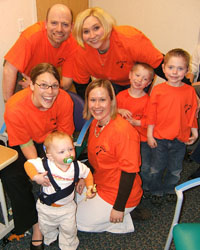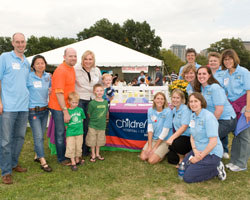 Luke Morra is just like any 18-month-old boy.
Luke Morra is just like any 18-month-old boy.
He loves dancing to music. He enjoys swimming and running through the sprinkler outside with his brothers. He’s constantly learning and points at things he finds interesting. He responds when his parents call his name.
The only difference is that Luke was born deaf.
After failing his newborn screening in the hospital, his parents Dan and Amy Morra took him to see specialists at St. Louis Children’s Hospital where evaluations revealed that Luke was born with severe hearing loss in his right ear. The hearing in his left ear was even worse.
His parents were devastated. Despite the fact that the Morra’s oldest son Jack was born with moderate hearing loss, their second son Nick had no hearing problems at all. When Luke was born, the Morras were overwhelmed by the severity of his diagnosis and the feeling they had to adjust their life expectations for him.
“After the diagnosis, Dan and I felt like we needed do something for Luke right away,” said Amy. “Immediately, one of the audiologists met with us and said, ‘I know this is a terrible day, but you’ll be okay.’ That made all the difference.”
Further testing and treatment over the next few months showed Luke was a candidate for a cochlear implant, an electronic prosthetic replacement for damaged hair cells in the inner ear. Unlike hearing aids, which amplify sounds to enable a person to hear, cochlear implants use a microphone and mini-computer to help convert everyday sounds into coded electrical pulses. These pulses stimulate the auditory nerve and the brain interprets the pulses as sound. The brain receives sound information so quickly that sounds are heard as soon as they occur.
An otolaryngologist, or ear, nose and throat specialist, implants the cochlear device in a procedure that typically takes two to three hours. In late March, Dr. Timothy Hullar performed Luke’s surgery, implanting a cochlear device in his right ear. Luke continues to use his hearing aid at his left ear. “During Luke’s surgery, his audiologist was right there with us in the operating room with a laptop and special software to perform diagnostics and stimulate his ear. Our team’s experience and the latest technology ensured that everything worked correctly right away.” Particularly after the surgery and receiving the device, the family gets personal calls from Luke’s audiologists who are “just checking in to see how he’s doing.”
 Just a few weeks later, Luke returned to St. Louis Children’s Hospital with his parents, his older brothers and more than 20 friends and extended family members for a big event. Dressed in custom-made orange t-shirts, the group watched intently as audiologists turned on Luke’s cochlear implant for the first time. 13-month-old Luke could now hear sound.
Just a few weeks later, Luke returned to St. Louis Children’s Hospital with his parents, his older brothers and more than 20 friends and extended family members for a big event. Dressed in custom-made orange t-shirts, the group watched intently as audiologists turned on Luke’s cochlear implant for the first time. 13-month-old Luke could now hear sound.
“After Luke’s implant, I distinctly remember seeing him in front of the TV watching one of his favorite shows,” Amy recalls. “He just stood there and stared in awe, I guess he finally realized the show had sound.”
As in Luke’s case, cochlear implants can make a major change in a hearing-impaired child’s development. “Parents should consider the size of a program, as one aspect in selection of a cochlear implant program,” says Dr. Hullar. “Higher patient volumes mean greater expertise and resources. Luke was the 500th cochlear implant for our program.” Dr. Hullar also recommends parents seek a cochlear implant program with a team approach in which surgeons, audiologists, researchers, speech pathologists, social workers and other support staff work closely together with the child and his family. “That comprehensive team makes a major difference in a child’s outcome and a family’s experience.”
Luke continues to make progress with frequent speech and language therapy both at home and through Central Institute for the Deaf (CID) in St Louis and the Kline House ‘Birth to 3’ Program through Illinois School for the Deaf. While Hullar continues to provide medical follow up as needed, Luke will continue to be followed regularly by the audiologists and speech language pathologists on the team long-term. Every three months, he visits St. Louis Children’s Hospital again for evaluation by the cochlear implant team.
“We like to provide strong support to our families throughout and after the process,” explains audiologist Jamie Cadieux. “We give information and emotional support,as families work toward acceptance of the diagnosis and become educated about treatment and communication options. It is important that families are comfortable and able to follow through with the decisions they make for their child, and Luke’s parents have done just that.”
For Luke’s education and for developing listening and speaking skills, his family is central. Amy is an ever-present educator, constantly narrating everything with Luke, talking about what he sees and does, always describing things and always teaching.
Life right now for Luke and the Morras is happily ”conventional”, according to Amy. Dan, a pediatrician, is enjoying a successful practice. Jack and Nick are enjoying their summer and continue to watch over their younger brother. Luke is preparing for nursery school. “I still read blogs of other parents who are frustrated, scared or don’t know what to expect for their children who are born deaf like Luke,” reflects Amy. “But we are fortunate to be in good hands right here at home with the team at Children’s.”
When asked about her future hopes for Luke, Amy quickly offers, “I want him to show others and be able to say ‘I was born deaf and I can lead whatever life I want without my hearing loss dictating what I can or cannot do.’”
At 18-months, Luke is well on his way.
St. Louis Children’s Hospital celebrated the 500th cochlear implant with Luke and other cochlear implant patients and their families at the 2008 Great Forest Park Balloon Race. For more information about the pediatric Cochlear Implant Program at St. Louis Children’s Hospital and Washington University, call 314.454.KIDS.










